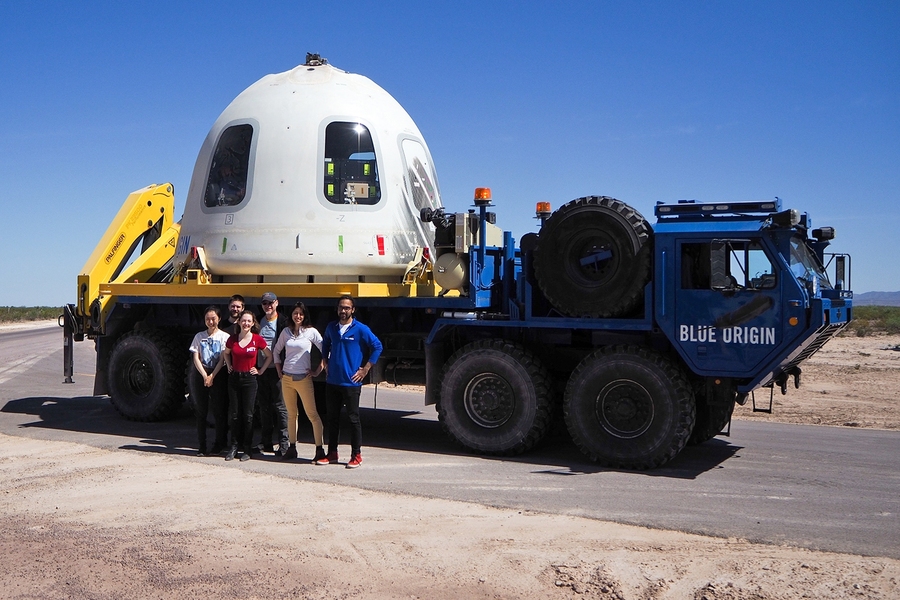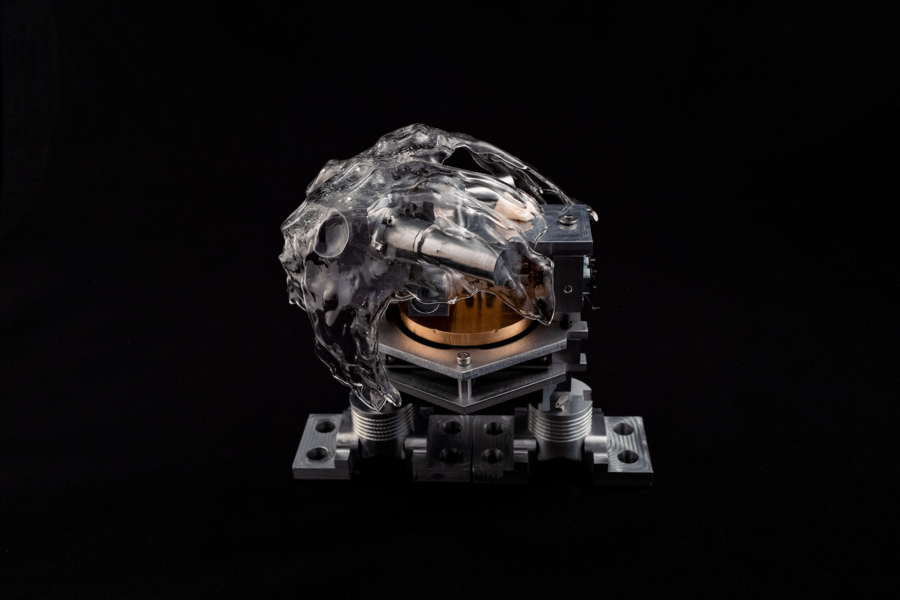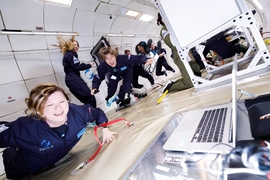Blast off! MIT made its latest foray into research in space on May 2 via six payloads from the Media Lab Space Exploration Initiative, tucked into Blue Origin’s New Shepard reusable space vehicle that took off from a launchpad in West Texas.
It was also the first time in the history of the Media Lab that in-house research projects were launched into space, for several minutes of sustained microgravity. The results of that research may have big implications for semiconductor manufacturing, art and telepresence, architecture and farming, among other things.
“The projects we’re testing operate fundamentally different in Earth’s gravity compared to how they would operate in microgravity,” explained Ariel Ekblaw, the founder and lead of the Media Lab’s Space Exploration Initiative.
Previously, the Media Lab sent projects into microgravity aboard the plane used by NASA to train astronauts, lovingly nicknamed “the vomit comet.” These parabolic flights provide repeated 15 to 30 second intervals of near weightlessness. The New Shepard experiment capsule will coast in microgravity for significantly longer and cross the Karman line (the formal boundary of “space”) in the process. While that may not seem like much time, it’s enough to get a lot accomplished.
“The capsule where the research takes place arcs through space for three minutes, which gives us precious moments of sustained, high quality microgravity,” Ekblaw said. “This provides an opportunity to expand our experiments from prior parabolic flight protocols, and test entirely new research as well.”
Depending on the results of the experiments done during New Shepard’s flight, some of the projects will undergo further, long-term research aboard the International Space Station, Ekblaw said.
On this trip, she sent Tessellated Electromagnetic Space Structures for the Exploration of Reconfigurable, Adaptive Environments, otherwise known as TESSERAE, into space. The ultimate goal for these sensor-augmented hexagonal and pentagonal “tiles” is to autonomously self-assemble into space structures. These flexible, reconfigurable modules can then be used for habitat construction, in-space assembly of satellites, or even as infrastructure for parabolic mirrors. Ekblaw hopes TESSERAE will one day support in-orbit staging bases for human exploration of the surface of the moon or Mars, or enable low Earth orbit space tourism.
An earlier prototype, flown on a parabolic flight in November 2017, validated the research concept mechanical structure, polarity arrangement of bonding magnets, and the self-assembly physical protocol. On the Blue Origin flight, Ekblaw is testing a new embedded sensor network in the tiles, as well as their communication architecture and guidance control aspects of their self-assembly capabilities. “We’re testing whether they’ll autonomously circulate, find correct neighbors, and bond together magnetically in microgravity for robust self-assembly,” Ekblaw said.
Another experiment aboard New Shepard combined art with the test of a tool for future space exploration — traversing microgravity with augmented mobility. Living Distance, an artwork conceived by the Space Exploration Initiative’s art curator, Xin Liu, explores freedom of movement via a wisdom tooth — yes, you read that correctly!
The tooth traveled to space carried by a robotic device named EBIFA and encased in a crystalline container. Once New Shepard entered space, the container burst open and EBIFA swung into action, shooting cords out with magnetic tips to latch onto a metal surface. The tooth then floated through space with minimal interference in the virtually zero-gravity environment.
“In this journey, the tooth became a newborn entity in space, its crystalline, sculptural body and life supported by an electromechanical system,” Xin Liu wrote. “Each of its weightless movements was carefully calculated on paper and modeled in simulation software, as there can never be a true test like this on Earth.”
The piece builds on a performance art work called Orbit Weaver that Liu performed last year during a parabolic flight, where she was physically tethered to a nylon cord that floated freely and attached to nearby surfaces. Orbit Weaver and Living Distance may offer insights to future human space explorers about how best to navigate weightlessness.
A piece of charcoal also made the trip to space inside a chamber lined with drawing paper, part of a project designed by Ani Liu, a Media Lab alumna. In microgravity, the charcoal will chart its own course inside the chamber, marking the paper as it floats through an arc far above the Earth.
When the chamber returns to the Media Lab, the charcoal will join forces with a KUKA robot that will mimic the charcoal’s trajectory during the three-ish minutes of coasting in microgravity. Together, the charcoal and the robot will become a museum exhibit that provides a demonstration of motion in microgravity to a broad audience and illustrates the Space Exploration Initiative’s aim to democratize access to space and invite the public to engage in space exploration.
Harpreet Sareen, another Media Lab alum, tested how crystals form in microgravity, research that may eventually lead to manufacturing semiconductors in space.
Semiconductors used in today’s technology require crystals with extremely high levels of purity and perfect shapes, but gravity interferes with crystal growth on Earth, resulting in faults, contact stresses, and other flaws. Sareen and his collaborator, Anna Garbier, created a nano-sized lab in a box a little smaller than a half-gallon milk carton. The electric current that kicked off growth of the crystals during the three minutes the New Shepard capsule was suborbital was triggered by onboard rocket commands from Blue Origin.
The crystals will be evaluated for potential industrial applications, and they also have a future as an art installation: Floral Cosmonauts.
And then there are the 40 or so bees (one might say “apionauts”) that made the trip into space on behalf of the Mediated Matter group at the Media Lab, which is interested in seeing the impact space travel has on a queen bee and her retinue. Two queen bees that were inseminated at a U.S. Department of Agriculture facility in Louisiana went to space, each with roughly 20 attendant bees whose job it was to feed her and help control her body temperature.
The bees traveled via two small containers — metabolic support capsules — into which they previously built honeycomb structures. This unique design gives them a familiar environment for their trip. A modified GoPro camera, pointed into the specially designed container housing the bees, was fitted into the top of the case to film the insects and create a record of their behavior during flight.
Everything inside the case was designed to make the journey as comfortable as possible for the bees, right down to a tiny golden heating pad that was to kick into action if the temperature dropped too low for a queen bee’s comfort.
Researchers in the Mediated Matter group will study the behavior of the bees when they return to Earth and are reintroduced to a colony at the Media Lab. Will the queens lay their eggs? Will those eggs hatch? And can bees who’ve been to space continue making pollen and honey once they’ve returned to Earth? Those are among the many questions the team will be asking.
“We currently have no robotic alternative to bees for pollination of many crops,” Ekblaw said. “If we want to grow crops on Mars, we may need to bring bees with us. Knowing if they can survive a mission, reintegrate into the hive, and thrive afterwards is critical.”
As these projects show, the Space Exploration Initiative unites engineers, scientists, artists, and designers across a multifaceted research portfolio. The team looks forward to a regular launch cadence and progressing through microgravity research milestones — from parabolic flights, to further launch opportunities with Blue Origin, to the International Space Station and even lunar landings.















